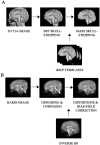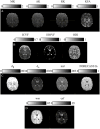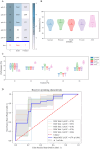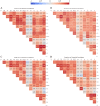Multi-view fusion of diffusion MRI microstructural models: a preterm birth study
- PMID: 39758885
- PMCID: PMC11695353
- DOI: 10.3389/fnins.2024.1480735
Multi-view fusion of diffusion MRI microstructural models: a preterm birth study
Abstract
Objective: High Angular Resolution Diffusion Imaging (HARDI) models have emerged as a valuable tool for investigating microstructure with a higher degree of detail than standard diffusion Magnetic Resonance Imaging (dMRI). In this study, we explored the potential of multiple advanced microstructural diffusion models for investigating preterm birth in order to identify non-invasive markers of altered white matter development.
Approach: Rather than focusing on a single MRI modality, we studied on a compound of HARDI techniques in 46 preterm babies studied on a 3T scanner at term-equivalent age and in 23 control neonates born at term. Furthermore, we investigated discriminative patterns of preterm birth using multiple analysis methods, drawn from two only seemingly divergent modeling goals, namely inference and prediction. We thus resorted to (i) a traditional univariate voxel-wise inferential method, as the Tract-Based Spatial Statistics (TBSS) approach; (ii) a univariate predictive approach, as the Support Vector Machine (SVM) classification; and (iii) a multivariate predictive Canonical Correlation Analysis (CCA).
Main results: The TBSS analysis revealed significant differences between preterm and term cohorts in several white matter areas for multiple HARDI features. SVM classification on skeletonized HARDI measures yielded satisfactory accuracy, particularly for highly informative parameters about fiber directionality. Assessment of the degree of overlap between the two methods in voting for the most discriminating features exhibited a good, though parameter-dependent, rate of agreement. Finally, CCA identified joint changes precisely for those measures exhibiting less correspondence between TBSS and SVM.
Significance: Our results suggest that a data-driven intramodal imaging approach is crucial for gathering deep and complementary information. The main contribution of this methodological outline is to thoroughly investigate prematurity-related white matter changes through different inquiry focuses, with a view to addressing this issue, both aiming toward mechanistic insight and optimizing predictive accuracy.
Keywords: diffusion Magnetic Resonance Imaging; inference; intramodal imaging approach; prediction; preterm birth.
Copyright © 2024 Trò, Roascio, Tortora, Severino, Rossi, Garyfallidis, Arnulfo, Fato and Fadnavis.
Conflict of interest statement
The authors declare that the research was conducted in the absence of any commercial or financial relationships that could be construed as a potential conflict of interest. The author(s) declared that they were an editorial board member of Frontiers, at the time of submission. This had no impact on the peer review process and the final decision.
Figures











References
LinkOut - more resources
Full Text Sources

